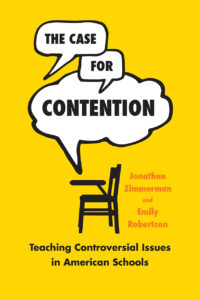 I’ve been reading Jonathan Zimmerman’s and Emily Robertson’s The Case for Contention: Teaching Controversial Issues in American Schools over the past few weeks.[1] In the course of reading I unexpectedly ran across a concept related to ignorance studies but, heretofore, unmentioned in those works and, yet, important to them.
I’ve been reading Jonathan Zimmerman’s and Emily Robertson’s The Case for Contention: Teaching Controversial Issues in American Schools over the past few weeks.[1] In the course of reading I unexpectedly ran across a concept related to ignorance studies but, heretofore, unmentioned in those works and, yet, important to them.
Books like the Proctor-Schiebinger volume cover many terms related to epistemology. Essayists therein discuss epistemic traps, epistemic tools, epistemic traditions, epistemic status, epistemic successes, epistemic concerns, epistemic weight, epistemic presumption, epistemic authority, and epistemic desideratum. But none so far, including the Conway-Oreskes book (Merchants of Doubt) have covered a key concept related to controversy–namely, “the epistemic criterion.”
The concept arises in the philosophical section of the Zimmerman-Robertson book, presumably in a chapter (three) written primarily by Robertson. Robertson is Associate Professor Emerita at Syracuse University, but this chapter contains a brief history of ‘the epistemic criterion’.
What is it? “The epistemic criterion” constitutes the requirements for making any issue controversial in relation to the current state of knowledge. Stated most simply, by Robertson, “controversial questions are ones where the best answer has yet to be determined to the satisfaction of the majority of informed persons.” And a bit more: “There is disagreement about which position is most likely to be right in light of the available evidence and reasoning. Each position is legitimate, having something to be said for it that would be acknowledged as good reasons by informed persons.” These questions are considered “open.” [p. 48]
In contrast are “settled” or “closed” questions. These are questions where the best answer is known to the satisfaction of most informed persons. There is little disagreement about the right position, because evidence is available, or reasoning is sound. Informed persons do not acknowledge potential answers that are contrary to reasoning and evidence. Arguing about these constitutes what one might call an epistemic trap, where one is trapped in a manufactured controversy.
Robertson’s history begins in 1937, with a lecture by Edward (Lee) Thorndike (1874-1949). Thorndike was an American psychologist who spent his entire career at Columbia’s Teachers College. Richard Hofstadter tells us that Thorndike was an ally of John Dewey, and the former was democrat who believed in applying science to education—even while maintaining his commitments to democracy. As with Dewey’s followers, some of Thorndike’s acolytes abused, or were overenthusiastic, about the potential fruits of education as a science, especially with regard to intelligence testing. Hofstadter absolves Thorndike of the problems among those who abused his ideas.[2]
Thorndike, in Robertson’s narrative, developed the epistemic criterion such that one could distill four conditions for controversial subjects:
1. There is a conflict or dispute, that is, a disagreement (i.e controversial issues are, in a broad sense, any subject that causes conflict or dispute);
2. The parties to the dispute are “fairly” competent with respect to the question at issue, that is, they are somewhat knowledgeable about the issue; …
3. The dispute is persistent and the parties have an emotional investment in it–the questions are what we might call “hot-button” issues;
4. Matters of public concern are at stake in the dispute. [p. 49]
Robertson extends this to say that when all four conditions are met, there is maximum controversy. In “Expert-Public disagreements,” there is disagreement between experts and a significan portion of the public. In this case, only conditions 1, 3, and 4 are met. Furthermore, in “Disagreements solely among experts,” only conditions 1 and 2 are met, but not 3 and 4. Robertson elaborates on these categories in pages 50-59.
I haven’t finished Robertson’s chapter but, from her notes, she relies afterward on her own work, Michael Hand’s 2008 article, “What Should We Teach as Controversial? A Defense of the Epistemic Criterion,” in Educational Theory (58:2, pp. 213-228), as well as work by Amy Gutmann, Diana Hess, Richard Rorty, and others. I look forward to Robertson’s full exploration—no matter if the exposition isn’t clear historically.
What is most interesting to me is how, after reading two books on history and theory of ignorance, no one provided a full philosophical exposition of what it means to call an issue, or question, “controversial.” It is assumed as common sense. The criteria outlined by Thorndike, and elaborated on by Robertson, provide some theoretical basis for everyone who thinks about controversy in history. We should all ask questions about the competency of parties involved (the spectrum), the persistence of particular controversies, the emotional investments, connections to public concern, and how controversies are maximal, minimal, or in-between. I think that all intellectual historians who deal with controversy do these things implicitly. But it’s interesting to see some terminology and philosophical criteria that help one be thorough. And it’s nice to have the theory’s name: “the epistemic criterion.” I predict this theory will help my own work on anti-intellectualism and further connections with ignorance.- TL
———————————————-
Notes
[1] Jonathan Zimmerman and Emily Robertson, The Case for Contention: Teaching Controversial Issues in American Schools (Chicago: University of Chicago Press, 2016).
[2] Richard Hofstadter, Anti-Intellectualism in American Life (New York: Knopf-Vintage, 1963), 338, 339.

0